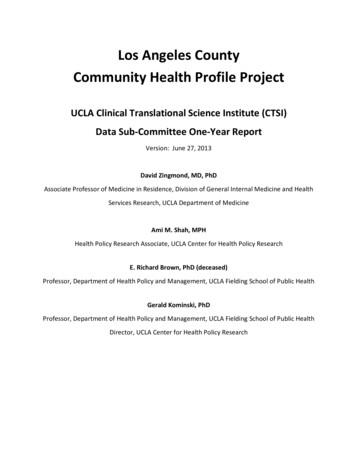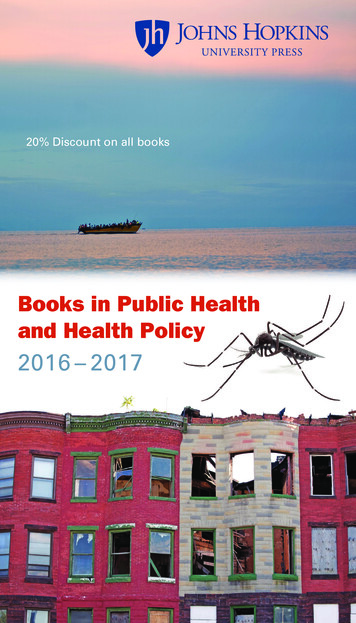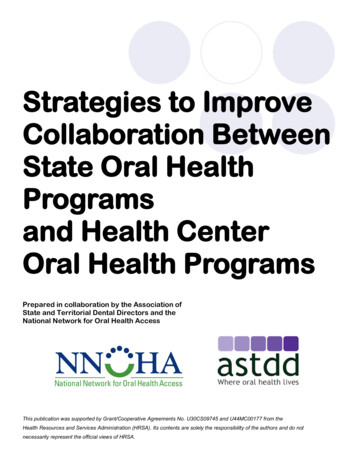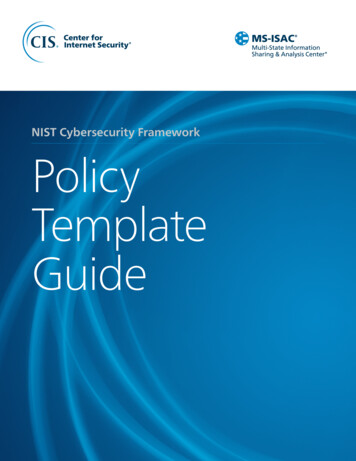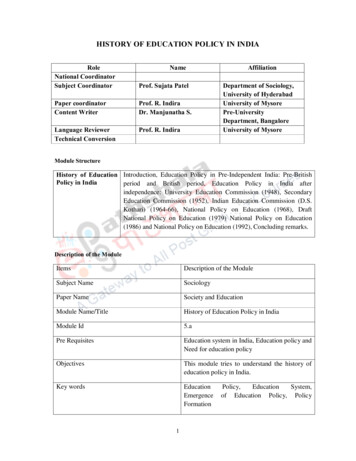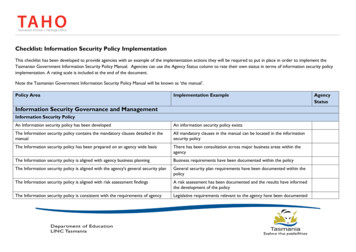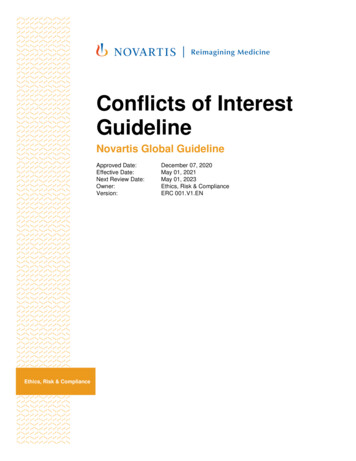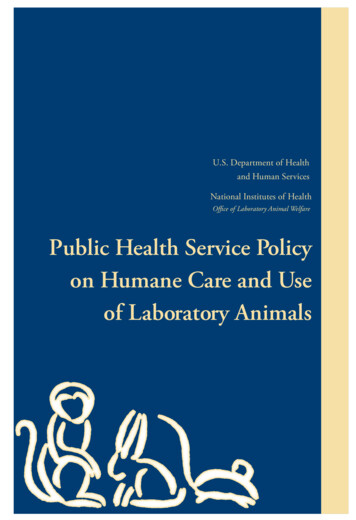
Transcription
U.S. Department of Healthand Human ServicesNational Institutes of HealthOffice of Laboratory Animal WelfarePublic Health Service Policyon Humane Care and Useof Laboratory Animals
Revised 2015Public Health Service Policyon Humane Care and Useof Laboratory Animals
PrefaceThis 2015 reprint of the Public Health Service (PHS) Policy on HumaneCare and Use of Laboratory Animals (Policy) is available in both printedand electronic formats. The electronic version may be found on the Office ofLaboratory Animal Welfare (OLAW) website at OLAW.nih.gov and includeshyperlinks to selected documents referred to in the text.The 2015 reprint of the PHS Policy reflects the following changes from the2002 reprint: (1) On January 1, 2012, OLAW adopted the Guide for theCare and Use of Laboratory Animals: Eighth Edition (Guide), an update of the1996 Seventh Edition, released by the National Academy of Sciences Insti tute for Laboratory Animal Research (ILAR) in 2011. Institutions with PHSAnimal Welfare Assurances implemented the Eighth Edition of the Guideduring 2012. (2) On February 26, 2013, the American Veterinary MedicalAssociation (AVMA) Panel on Euthanasia released the AVMA Guidelines forthe Euthanasia of Animals: 2013 Edition (Guidelines). PHS Assured insti tutions implemented the 2013 AVMA Guidelines during the period fromMarch 1, 2013, to September 1, 2013. (3) The OLAW mail address has beenremoved and electronic and fax contact information has been provided tofacilitate efficient communication and conserve resources. (4) Footnotes 2,7, 9, 11, and 13 have been modified to require PHS Assured institutions tocomply with U.S. Department of Agriculture regulations that are applicableto their programs. (5) A change in format, but not content, was made toPHS Policy IV.B.3. (6) Grammatical corrections were made to reflect currentwriting standards.This reprint includes the Health Research Extension Act of 1985, Public Law99-158, “Animals in Research” (November 20, 1985), which provides thestatutory mandate for the PHS Policy. Also included in this reprint are theU.S. Government Principles for the Utilization and Care of Vertebrate Ani mals Used in Testing, Research, and Training (Principles). The U.S. Principleswere promulgated in 1985 by the Interagency Research Animal Committeeand adopted by U.S. Government agencies that either develop requirementsfor or sponsor procedures involving the use of vertebrate animals. The Princi ples were incorporated into the PHS Policy in 1986 and continue to providea framework for conducting research in accordance with the Policy.OLAW, which has responsibility for the general administration and coordi nation of the Policy, provides specific guidance, instruction, and materials toinstitutions that must comply with the Policy. For supplemental materials,please contact OLAW at the National Institutes of Health at olaw@od.nih.gov, or visit the OLAW website at OLAW.nih.gov.
Table of ContentsHealth Research Extension Act of 1985, Public Law 99-158,November 20, 1985, “Animals in Research” . 1U.S. Government Principles for the Utilization and Care ofVertebrate Animals Used in Testing, Research, and Training . 4Public Health Service Policy on Humane Care and Use ofLaboratory Animals . 7I. Introduction. 7II. Applicability. 7III. Definitions . 8IV. Implementation by Institutions . 9A. Animal Welfare Assurance . 9B. Functions of the Institutional Animal Careand Use Committee . 12C. Review of PHS-Conducted or SupportedResearch Projects . 13D. Information Required in Applications andProposals for Awards Submitted to the PHS . 16E. Recordkeeping Requirements . 17F. Reporting Requirements . 17V. Implementation by the PHS . 18A. Responsibilities of the Office of LaboratoryAnimal Welfare . 18B. Responsibilities of PHS Awarding Units . 19C. Conduct of Special Reviews/Site Visits . 19D. Waiver . 19
1Health Research Extension Act of 1985Public Law 99-158November 20, 1985, “Animals in Research”Sec. 495.(a) The Secretary, acting through the Director of NIH, shall establish guide lines for the following:“(1) The proper care of animals to be used in biomedical and behavioralresearch.“(2) The proper treatment of animals while being used in such research.Guidelines under this paragraph shall require—“(A) the appropriate use of tranquilizers, analgesics, anesthetics, par alytics, and euthanasia for animals in such research; and“(B) appropriate pre-surgical and post-surgical veterinary medicaland nursing care for animals in such research.Such guidelines shall not be construed to prescribe methods of research.“(3) The organization and operation of animal care committees in accor dance with subsection (b).“(b) (1) Guidelines of the Secretary under subsection (a)(3) shall requireanimal care committees at each entity which conducts biomedical andbehavioral research with funds provided under this Act (including theNational Institutes of Health and the national research institutes) toassure compliance with the guidelines established under subsection (a).“(2) Each animal care committee shall be appointed by the chief execu tive officer of the entity for which the committee is established, shall becomposed of not fewer than three members, and shall include at leastone individual who has no association with such entity and at least onedoctor of veterinary medicine.“(3) Each animal care committee of a research entity shall—“(A) review the care and treatment of animals in all animal studyareas and facilities of the research entity at least semiannually to eval uate compliance with applicable guidelines established under subsec tion (a) for appropriate animal care and treatment;
2Health Research Extension Act of 1985“(B) keep appropriate records of reviews conducted under subpara graph (A); and“(C) for each review conducted under subparagraph (A), file with theDirector of NIH at least annually (i) a certification that the reviewhas been conducted, and (ii) reports of any violations of guidelinesestablished under subsection (a) or assurances required under para graph (1) which were observed in such review and which have con tinued after notice by the committee to the research entity involvedof the violations.Reports filed under subparagraph (C) shall include any minority views filedby members of the committee.“(c) The Director of NIH shall require each applicant for a grant, contract,or cooperative agreement involving research on animals which is adminis tered by the National Institutes of Health or any national research instituteto include in its application or contract proposal, submitted after the expira tion of the twelve-month period beginning on the date of enactment of thissection—“(1) assurances satisfactory to the Director of NIH that—“(A) the applicant meets the requirements of the guidelines estab lished under paragraphs (1) and (2) of subsection (a) and has ananimal care committee which meets the requirements of subsection(b); and“(B) scientists, animal technicians, and other personnel involvedwith animal care, treatment, and use by the applicant have availableto them instruction or training in the humane practice of animalmaintenance and experimentation, and the concept, availability, anduse of research or testing methods that limit the use of animals orlimit animal distress; and“(2) a statement of the reasons for the use of animals in the research to beconducted with funds provided under such grant or contract.Notwithstanding subsection (a)(2) of section 553 of title 5, United StatesCode, regulations under this subsection shall be promulgated in accordancewith the notice and comment requirements of such section.“(d) If the Director of NIH determines that—“(1) the conditions of animal care, treatment, or use in an entity which isreceiving a grant, contract, or cooperative agreement involving researchon animals under this title do not meet applicable guidelines establishedunder subsection (a);
Public Law 99-1583“(2) the entity has been notified by the Director of NIH of such deter mination and has been given a reasonable opportunity to take correctiveaction; and“(3) no action has been taken by the entity to correct such conditions;the Director of NIH shall suspend or revoke such grant or contract undersuch conditions as the Director determines appropriate.“(e) No guideline or regulation promulgated under subsection (a) or (c) mayrequire a research entity to disclose publicly trade secrets or commercial orfinancial information which is privileged or confidential.”
4U.S. Government Principles for theUtilization and Care of Vertebrate AnimalsUsed in Testing, Research, and TrainingThe development of knowledge necessary for the improvement of the healthand well-being of humans as well as other animals requires in vivo experi mentation with a wide variety of animal species. Whenever U.S. Governmentagencies develop requirements for testing, research, or training proceduresinvolving the use of vertebrate animals, the following principles shall be con sidered; and whenever these agencies actually perform or sponsor such proce dures, the responsible Institutional Official shall ensure that these principlesare adhered to:I.The transportation, care, and use of animals should be in accordancewith the Animal Welfare Act (7 U.S.C. 2131 et seq.) and other applica ble Federal laws, guidelines, and policies.*II.Procedures involving animals should be designed and performed withdue consideration of their relevance to human or animal health, theadvancement of knowledge, or the good of society.III.The animals selected for a procedure should be of an appropriate speciesand quality and the minimum number required to obtain valid results.Methods such as mathematical models, computer simulation, and invitro biological systems should be considered.IV.Proper use of animals, including the avoidance or minimization ofdiscomfort, distress, and pain when consistent with sound scientificpractices, is imperative. Unless the contrary is established, investigatorsshould consider that procedures that cause pain or distress in humanbeings may cause pain or distress in other animals.V.Procedures with animals that may cause more than momentary orslight pain or distress should be performed with appropriate sedation,analgesia, or anesthesia. Surgical or other painful procedures should notbe performed on unanesthetized animals paralyzed by chemical agents.* For guidance throughout these Principles, the reader is referred to the Guide for the Care and Use ofLaboratory Animals prepared by the Institute for Laboratory Animal Research, National Academy ofSciences.
U.S. Government PrinciplesVI.5Animals that would otherwise suffer severe or chronic pain or distressthat cannot be relieved should be painlessly killed at the end of theprocedure or, if appropriate, during the procedure.VII. The living conditions of animals should be appropriate for their speciesand contribute to their health and comfort. Normally, the housing,feeding, and care of all animals used for biomedical purposes must bedirected by a veterinarian or other scientist trained and experienced inthe proper care, handling, and use of the species being maintained orstudied. In any case, veterinary care shall be provided as indicated.VIII. Investigators and other personnel shall be appropriately qualified andexperienced for conducting procedures on living animals. Adequatearrangements shall be made for their in-service training, including theproper and humane care and use of laboratory animals.IX.Where exceptions are required in relation to the provisions of thesePrinciples, the decisions should not rest with the investigators directlyconcerned but should be made, with due regard to Principle II, by anappropriate review group, such as an institutional animal care and usecommittee. Such exceptions should not be made solely for the purposesof teaching or demonstration.** Published in the Federal Register, May 20, 1985, Vol. 50, No. 97, by the Office of Science and TechnologyPolicy [FR Doc. 85-12059].
7Public Health Service Policy on Humane Careand Use of Laboratory AnimalsI. IntroductionIt is the Policy of the Public Health Service (PHS) to require institutions toestablish and maintain proper measures to ensure the appropriate care anduse of all animals involved in research, research training, and biological test ing activities (hereinafter referred to as “activities”) conducted or supportedby the PHS. The PHS endorses the “U.S. Government Principles for theUtilization and Care of Vertebrate Animals Used in Testing, Research, andTraining” developed by the Interagency Research Animal Committee. ThisPolicy is intended to implement and supplement those Principles.II. ApplicabilityThis Policy is applicable to all PHS-conducted or supported activities involv ing animals, whether the activities are performed at a PHS agency, an awardeeinstitution, or any other institution and conducted in the United States, theCommonwealth of Puerto Rico, or any territory or possession of the UnitedStates. Institutions in foreign countries receiving PHS support for activitiesinvolving animals shall comply with this Policy, or shall provide evidence tothe PHS that acceptable standards for the humane care and use of the animalsin PHS-conducted or supported activities will be met. No PHS support foran activity involving animals will be provided to an individual unless thatindividual is affiliated with or sponsored by an institution which can and doesassume responsibility for compliance with this Policy, unless the individualmakes other arrangements with the PHS. This Policy does not affect applica ble state or local laws or regulations that impose more stringent standards forthe care and use of laboratory animals. All institutions are required to comply,as applicable, with the Animal Welfare Act and with other Federal statutesand regulations relating to animals.
8DefinitionsIII. DefinitionsA. Animal – Any live, vertebrate animal used or intended for use in research,research training, experimentation, or biological testing or for related pur poses.B. Animal Facility – Any and all buildings, rooms, areas, enclosures, or vehi cles, including satellite facilities, used for animal confinement, transport,maintenance, breeding, or experiments inclusive of surgical manipulation. Asatellite facility is any containment outside of a core facility or centrally desig nated or managed area in which animals are housed for more than 24 hours.C. Animal Welfare Act – Public Law 89-544, 1966, as amended (P.L. 91-579,P.L. 94-279, and P.L. 99-198), 7 U.S.C. 2131 et seq. Implementing reg ulations are published in the Code of Federal Regulations (CFR), Title 9,Chapter 1, Subchapter A, Parts 1, 2, and 3, and are administered by the U.S.Department of Agriculture.D. Animal Welfare Assurance or Assurance – The documentation from aninstitution assuring institutional compliance with this Policy.E. Guide – Guide for the Care and Use of Laboratory Animals: Eighth Edition,National Academy Press, 2011, Washington, D.C., or succeeding revised edi tions.F. Institution – Any public or private organization, business, or agency(including components of Federal, state, and local governments).G. Institutional Official – An individual who signs, and has the authorityto sign, the institution’s Assurance, making a commitment on behalf of theinstitution that the requirements of this Policy will be met.H. Public Health Service – The Public Health Service, or the PHS, includesthe Agency for Healthcare Research and Quality, the Centers for DiseaseControl and Prevention, the Food and Drug Administration, the HealthResources and Services Administration, the Indian Health Service, theNational Institutes of Health, and the Substance Abuse and Mental HealthServices Administration.I. Quorum – A majority of the members of the Institutional Animal Care andUse Committee (IACUC).
PHS Policy on Humane Care and Use of Laboratory Animals9IV. Implementation by InstitutionsA. Animal Welfare AssuranceNo activity involving animals may be conducted or supported by the PHS untilthe institution conducting the activity has provided a written Assurance accept able to the PHS, setting forth compliance with this Policy. Assurances shall besubmitted to the Office of Laboratory Animal Welfare (OLAW), Office of theDirector, National Institutes of Health (NIH).1 The Assurance shall be signedby the Institutional Official. OLAW will provide the institution with necessaryinstructions and an example of an acceptable Assurance. All Assurances sub mitted to the PHS in accordance with this Policy will be evaluated by OLAWto determine the adequacy of the institution’s proposed program for the careand use of animals in PHS-conducted or supported activities. On the basis ofthis evaluation, OLAW may approve or disapprove the Assurance, or negotiatean approvable Assurance with the institution. Approval of an Assurance willbe for a specified period of time (no longer than five years) after which timethe institution must submit a new Assurance to OLAW. OLAW may limit theperiod during which any particular approved Assurance shall remain effectiveor otherwise condition, restrict, or withdraw approval. Without an applicablePHS-approved Assurance, no PHS-conducted or supported activity involvinganimals at the institution will be permitted to continue.1. Institutional Program for Animal Care and UseThe Assurance shall fully describe the institution’s program for the careand use of animals in PHS-conducted or supported activities. The PHSrequires institutions to use the Guide for the Care and Use of LaboratoryAnimals (Guide) as a basis for developing and implementing an institu tional program for activities involving animals.2 The program descriptionmust include the following:a. a list of every branch and major component of the institution, as well as alist of every branch and major component of any other institution,which is to be included under the Assurance;b. the lines of authority and responsibility for administering the programand ensuring compliance with this Policy;12Assurances should be sent to OLAW, NIH, by e-mail to olawdoa@mail.nih.gov or by fax to301-451-5672.This Policy requires that Assured institutions base their programs of animal care and use on the Guidefor the Care and Use of Laboratory Animals and that they comply with the applicable regulations (9 CFR,Subchapter A) issued by the U.S. Department of Agriculture (USDA) under the Animal Welfare Act.The Guide may differ from USDA regulations in some respects. Compliance with applicable USDAregulations is an absolute requirement of this Policy.
10Implementation by Institutionsc. the qualifications, authority, and responsibility of the veterinarian(s)who will participate in the program and the percent of time each willcontribute to the program;d. the membership list of the Institutional Animal Care and Use Com mittee(s) (IACUC) established in accordance with the requirementsset forth in IV.A.3. of this Policy;3e. the procedures that the IACUC will follow to fulfill the requirementsset forth in this Policy;f.the health program for personnel who work in laboratory animalfacilities or have frequent contact with animals;g. a synopsis of training or instruction in the humane practice ofanimal care and use, as well as training or instruction in researchor testing methods that minimize the number of animals requiredto obtain valid results and minimize animal distress, offered to sci entists, animal technicians, and other personnel involved in animalcare, treatment, or use;h. the gross square footage of each animal facility (including satellitefacilities), the species housed therein, and the average daily inven tory, by species, of animals in each facility; andi.any other pertinent information requested by OLAW.2. Institutional StatusEach institution must assure that its program and facilities are in one ofthe following categories:Category 1 – Accredited by the Association for Assessment and Accred itation of Laboratory Animal Care International (AAALAC). All of theinstitution’s programs and facilities (including satellite facilities) for activ ities involving animals have been evaluated and accredited by AAALAC,or another accrediting body recognized by the PHS.4 All of the institu tion’s programs and facilities (including satellite facilities) for activitiesinvolving animals have also been evaluated by the IACUC and will bereevaluated by the IACUC at least once every six months, in accordancewith IV.B.1. and 2. of this Policy, and reports prepared in accordancewith IV.B.3. of this Policy.3The name Institutional Animal Care and Use Committee (IACUC) as used in this Policy is intendedas a generic term for a committee whose function is to ensure that the care and use of animals in PHSconducted or supported activities are appropriate and humane in accordance with this Policy. However,each institution may identify the committee by whatever name it chooses.4As of the 2015 revision of this Policy, the only accrediting body recognized by the PHS is AAALAC.
PHS Policy on Humane Care and Use of Laboratory Animals11Category 2 – Evaluated by the Institution. All of the institution’s pro grams and facilities (including satellite facilities) for activities involvinganimals have been evaluated by the IACUC. These programs and facili ties will be reevaluated by the IACUC at least once every six months, inaccordance with IV.B.1. and 2. of this Policy, and reports will be preparedin accordance with IV.B.3. of this Policy. The most recent semiannualreport of the IACUC evaluation shall be submitted to OLAW with theAssurance.3. Institutional Animal Care and Use Committeea. The Chief Executive Officer shall appoint an IACUC, qualifiedthrough the experience and expertise of its members to oversee theinstitution’s animal program, facilities, and procedures.5b. The Assurance must include the names,6 position titles, and creden tials of the IACUC chairperson and the members. The committeeshall consist of no fewer than five members, and shall include at least:(1) one Doctor of Veterinary Medicine, with training or experiencein laboratory animal science and medicine, who has direct or dele gated program authority and responsibility for activities involvinganimals at the institution (see IV.A.1.c.);(2) one practicing scientist experienced in research involving animals;(3) one member whose primary concerns are in a nonscientific area(e.g., ethicist, lawyer, and member of the clergy); and(4) one individual who is not affiliated with the institution in anyway other than as a member of the IACUC, and is not a member ofthe immediate family of a person who is affiliated with the institu tion.c. An individual who meets the requirements of more than one of thecategories detailed in IV.A.3.b.(1)-(4) of this Policy may fulfill morethan one requirement. However, no committee may consist of fewerthan five members.5The Health Research Extension Act of 1985 requires the IACUC to be appointed by the Chief ExecutiveOfficer (CEO) of the entity for which the committee is established. OLAW considers the CEO to be thehighest operating official of the organization (such as the President of a University). If the CEO delegatesauthority to appoint the IACUC then the delegation must be specific and in writing. The CEO may ormay not be the Institutional Official as defined by this Policy (see definition at III.G.).6Institutions may, at their discretion, represent the names of members other than the chairperson andveterinarian with program authority (see IV.A.3.) by using numbers or other symbols in submissions toOLAW. Sufficient information for OLAW to determine that all appointees are appropriately qualifiedmust be provided. The identity of each member must be readily ascertainable by the institution andavailable to authorized OLAW or other PHS representatives upon request.
12Implementation by InstitutionsB. Functions of the Institutional Animal Care and Use CommitteeAs an agent of the institution, the IACUC shall with respect to PHSconducted or supported activities:1. review at least once every six months the institution’s program forhumane care and use of animals, using the Guide as a basis for eval uation;72. inspect at least once every six months all of the institution’s animalfacilities (including satellite facilities) using the Guide as a basis forevaluation;3. prepare reports of the IACUC evaluations conducted as required byIV.B.1. and 2. of this Policy, and submit the reports to the Institu tional Official;8(The reports must meet the following criteria:a. The reports shall be updated at least once every six months uponcompletion of the required semiannual evaluations.b. The reports shall be maintained by the institution and madeavailable to OLAW upon request.c. The reports must contain a description of the nature and extentof the institution’s adherence to the Guide and this Policy andmust identify specifically any departures from the provisions ofthe Guide and this Policy, and must state the reasons for eachdeparture.d. The reports must distinguish significant deficiencies from minordeficiencies. A significant deficiency is one that, consistent withthis Policy, and, in the judgment of the IACUC and the Insti tutional Official, is or may be a threat to the health or safety ofthe animals. If program or facility deficiencies are noted, the reportsmust contain a reasonable and specific plan and schedule for cor recting each deficiency.e. If some or all of the institution’s facilities are accredited byAAALAC or another accrediting body recognized by the PHS,the report should identify those facilities as such.)7This Policy requires that Assured institutions base their programs of animal care and use on the Guide for theCare and Use of Laboratory Animals and that they comply with the applicable regulations (9 CFR, SubchapterA) issued by USDA under the Animal Welfare Act. The Guide may differ from USDA regulations in somerespects. Compliance with applicable USDA regulations is an absolute requirement of this Policy.8The IACUC may, at its discretion, determine the best means of conducting an evaluation of theinstitution’s programs and facilities. The IACUC may invite ad hoc consultants to assist in conductingthe evaluation. However, the IACUC remains responsible for the evaluation and report.
PHS Policy on Humane Care and Use of Laboratory Animals134. review concerns involving the care and use of animals at the institu tion;5. make recommendations to the Institutional Official regarding anyaspect of the institution’s animal program, facilities, or personneltraining;6. review and approve, require modifications in (to secure approval), orwithhold approval of those components of PHS-conducted or sup ported activities related to the care and use of animals as specified inIV.C. of this Policy;7. review and approve, require modifications in (to secure approval),or withhold approval of proposed significant changes regarding theuse of animals in ongoing activities; and8. be authorized to suspend an activity involving animals in accordancewith the specifications set forth in IV.C.6. of this Policy.C. Review of PHS-Conducted or Supported Research Projects1. In order to approve proposed research projects or proposed signifi cant changes in ongoing research projects, the IACUC shall conducta review of those components related to the care and use of animalsand determine that the proposed research projects are in accordancewith this Policy. In making this determination, the IACUC shallconfirm that the research project will be conducted in accordancewith the Animal Welfare Act insofar as it applies to the research proj ect, and that the research project is consistent with the Guide unlessacceptable justification for a departure is presented.9 Further, theIACUC shall determine that the research project conforms with theinstitution’s Assurance and meets the following requirements:a. Procedures with animals will avoid or minimize discomfort, dis tress, and pain to the animals, consistent with sound researchdesign.b. Procedures that may cause more than momentary or slight painor distress to the animals will be performed with appropriatesedation, analgesia, or anesthesia, unless the procedure is justi fied for scientific reasons in writing by the investigator.9This Policy requires that Assured institutions base their programs of animal care and use on the Guidefor the Care and Use of Laboratory Animals and that they comply with the applicable regulations (9 CFR,Subchapter A) issued by USDA under the Animal Welfare Act. The Guide may differ from USDAregulations in some respects. Compliance with applicable USDA regulations is an absolute requirementof this Policy.
14Implementation by Institutionsc. Animals tha
Guide for the Care and Use of Laboratory Animals: Eighth Edition (Guide), an update of the 1996 Seventh Edition, released by the National Academy of Sciences Insti tute for Laboratory Animal Research (ILAR) in 2011. Institutions with PHS Animal Welfare Assurances implemented the Eighth Edition of the . Guide . during 2012.


